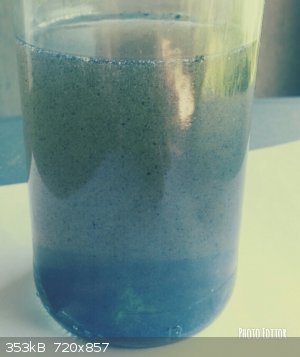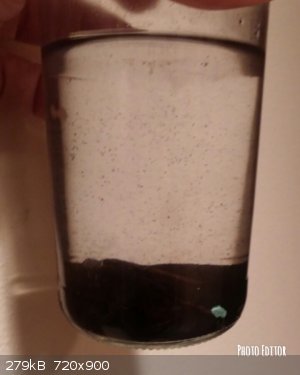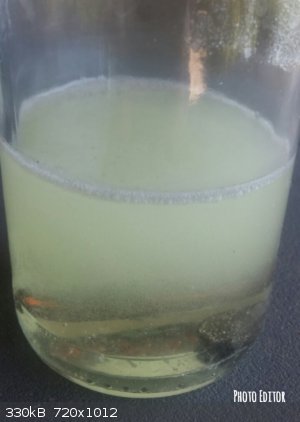AJKOER
Radically Dubious
    
Posts: 3026
Registered: 7-5-2011
Member Is Offline
Mood: No Mood
|
|
Experimental Variants of Bleach Battery to Obtain Metal Oxides (like CuO)
Background:
I have previously, reported on the so called Bleach Battery (see http://www.sciencemadness.org/talk/viewthread.php?tid=81796#... ) which employs an aluminum metal anode, a copper metal cathode, an electrolyte
consisting of a touch of added sea salt to aqueous NaOCl or HOCl. Following an anodic attack on Aluminum, one product is Al(OH)3. Previously, I
alluded to a result with Zinc metal in place of Al resulting in Zn(OH)2 / ZnO (see http://www.sciencemadness.org/talk/viewthread.php?tid=75990#... ).
In this reported experiment, I employed Copper metal along with an interesting commonly available source of a more noble metal composite. Per this
source, https://www.engineersedge.com/galvanic_capatability.htm , reportedly nickel and high nickel-copper alloys are more noble than pure copper itself,
which is not completely unexpected as Ni-Cu alloy commonly employed in coins are likely chosen, in part, for corrosion resistant. So, this experiment
tests this metal composite as the cathode versus an anode (actually, an anodic zone, as opposed to a cathodic zone, as no singular electrode with an
external wire connection) of pure copper metal in a variant of the bleach battery. The concept is that anodic attack of the now less noble copper
metal will form an oxide, with the latter oxide formation being the intended product of interest.
Experiment Performed:
Reagents: 8.25% plain Chlorine Bleach, Copper metal from Cu tubing used in plumbing, sea salt as commonly marketed seasoning, and U.S. ‘Silver’
coins as described below.
Procedure: One 90% silver coin and the other reagents were combined and the aqueous heated for 60 seconds in a conventional microwave in a well
ventilated area to jump start the reaction. After 3 hours, more bleach was added along with a second nickel-copper ‘silver’ coin.
With respect to the Ag coins, more precisely, I used a 1962 U.S. dime which is 90% Silver and 20% copper, as are all U.S. quarters and dimes minted
before 1964. Other US dimes and quarters issued 1964 to 1984 can be 100% silver clad if issued as proof collector coins otherwise, there are very
likely the inexpensive Ni-Cu alloy (see https://en.wikipedia.org/wiki/Quarter_(United_States_coin) . In this experiment, I also inserted into the
electrochemical cell a second coin, a circulated 1977 Silver Quarter, a cupronickel alloy (75% Cu/ 25% Ni), reputedly lower in the anodic index than
pure copper, some 3 hours after the 90% silver dime.
Results:
Success! As expected a cloud of black particles formed which finally in 12 hours collected at the bottom burying all sight of the copper metal and
corresponding metal coins. The copper anode was totally black and the all coins (which do contained alloyed Cu) were also discolored. I have since
used half of my yield as a catalyst in a new experiment.
The process is extremely easy on reagents as compared to other methods claimed to be facile (see, for example, https://link.springer.com/article/10.1007/s00339-002-1514-5 ), but did not result in nano-particles, although adding a surfactant may aid in
reducing particle size.
Interestingly, the reaction cloud in the first picture did not really occur until 2 hours after adding the larger quarter! In other words, the CuO
production increased when the cathode surface area increased relative to the anode (the copper tubing).
----------------------------------------------
Note, all coins (acting as the noble metal electrode) were treated/cleaned following the experiment so as not to be destroyed or rendered intentional
damage.
-------------------------------------------------------------------
Note, as to the underlying mechanics of Cupric oxide formation, I speculate that the NaOCl/HOCl first acts electrochemically on Cu to form Cu2O. The
latter cuprous forms a soluble complex with say chloride followed by a Fenton-type redox creating cupric. My take:
Cu(l) + HOCl → Cu(II) + ClOH•-
Followed by either of the following reactions, depending on pH or presence of bicarbonate:
ClOH•- → Cl- + OH• k = 6.1×10^9
ClOH•- + H+ → Cl• + H2O k = 2.1×10^10
Cl• + HCO3- → Cl- + H+ + CO3•- k =2.2×10^8
Also: Cu + Cu(ll) = 2 Cu(l) , may be part of a surface reaction on copper metal.


[Edited on 14-6-2018 by AJKOER]
|
|
|
AJKOER
Radically Dubious
    
Posts: 3026
Registered: 7-5-2011
Member Is Offline
Mood: No Mood
|
|
Starting picture:

[Edited on 14-6-2018 by AJKOER]
|
|
|
aga
Forum Drunkard
    
Posts: 7030
Registered: 25-3-2014
Member Is Offline
|
|
The objective was to make CuO ?
The is no 'normal' electrical connection between the coins ?
Forgive me for being little confused.
|
|
|
AJKOER
Radically Dubious
    
Posts: 3026
Registered: 7-5-2011
Member Is Offline
Mood: No Mood
|
|
Aga:
Actually, in the classic bleach battery, one can connect wires to the Al and Cu metal electrodes as an electrical power source.
In the current application, one could make a pile of coins extending out of the solution and connect a wire. The copper tubing could also be wired.
Then, run the wires through a volt meter to measure power output.
Note, for an electrochemical reaction, as I noted above, the relative (cathode vs. anode) exposed surface area of the electrodes is material with
respect to galvanic corrosion occurring at the anode (the pure copper metal tubing). Source: see https://corrosion-doctors.org/Corrosion-Forms/area-effects.h... .
[Edited on 14-6-2018 by AJKOER]
|
|
|
AJKOER
Radically Dubious
    
Posts: 3026
Registered: 7-5-2011
Member Is Offline
Mood: No Mood
|
|
Found a prior thread on SM discussing Cu(OH)2/CuO.
See http://www.sciencemadness.org/talk/viewthread.php?tid=70704#... .
Comments for a standard electrolysis approach at http://www.sciencemadness.org/talk/viewthread.php?tid=62872#... .
I believe the methodology of this thread can be described as electrosynthesis of CuO based on a voltaic electrochemical cell.
[Edited on 15-6-2018 by AJKOER]
|
|
|
aga
Forum Drunkard
    
Posts: 7030
Registered: 25-3-2014
Member Is Offline
|
|
Hmm.
Your idea of piling the coins reminds me of the 'railway' battery which i think was zinc/copper salts.
As i recall, one was denser than the other so they did not mix, but formed 2 layers.
A pile of coins could easily make a cell with no external connections, they being made by the salts in the upper and lower layers, if the coins were
piled high enough.
Not sure what application that may have, but the 'cell' would be self-contained.
|
|
|
Jose
Harmless

Posts: 17
Registered: 18-12-2016
Member Is Offline
Mood: No Mood
|
|
I did the same type of reaction recently using a small surface area 1mm thick iron wire with several thick copper wire knitted together, the
electrolyte being my own urine. In less than 2 minutes there was a thick cloud of Fe2O3 in the urine solution. I was trying to remove cloride ions
through the galvanic reaction.
You can repeat your experiment by using large surface area carbon rods with thin copper wire. You will be surprised at how fast the reaction happens.
|
|
|
AJKOER
Radically Dubious
    
Posts: 3026
Registered: 7-5-2011
Member Is Offline
Mood: No Mood
|
|
Jose:
Thanks for the comment.
|
|
|